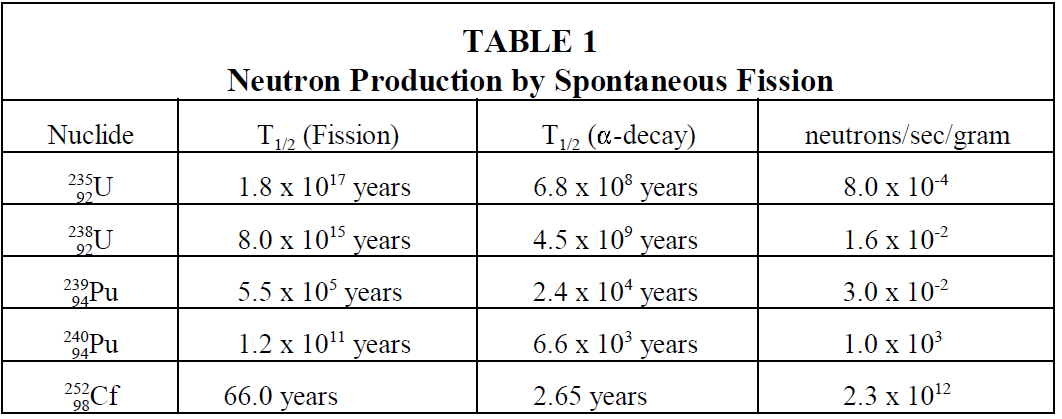
Intrinsic Neutron Sources
 المؤلف:
U.S. Department of Commerce, National Technical Information Service, 1993
المؤلف:
U.S. Department of Commerce, National Technical Information Service, 1993
 المصدر:
The Nuclear Physics and Reactor Theory Handbook
المصدر:
The Nuclear Physics and Reactor Theory Handbook
 الجزء والصفحة:
...
الجزء والصفحة:
...
 5-4-2017
5-4-2017
 2886
2886
Intrinsic Neutron Sources
Some neutrons will be produced in the materials present in the reactor due to a variety of unavoidable reactions that occur because of the nature of these materials. Intrinsic neutron sources are those neutron-producing reactions that always occur in reactor materials.
A limited number of neutrons will always be present, even in a reactor core that has never been operated, due to spontaneous fission of some heavy nuclides that are present in the fuel. Uranium- 238, uranium-235, and plutonium-239 undergo spontaneous fission to a limited extent. Uranium- 238, for example, yields almost 60 neutrons per hour per gram. Table 1 illustrates a comparison of the rate at which different heavy nuclides produce neutrons by spontaneous fission. Californium-252 is not an intrinsic neutron source, but will be discussed in the section on installed neutron sources.

Another intrinsic neutron source is a reaction involving natural boron and fuel. In some reactors, natural boron is loaded into the reactor core as a neutron absorber to improve reactor control or increase core life-time. Boron-11 (80.1% of natural boron) undergoes a reaction with the alpha particle emitted by the radioactive decay of heavy nuclides in the fuel to yield a neutron as shown below.

The boron-11 must be mixed with, or in very close proximity to, the fuel for this reaction because of the short path length of the alpha particle. For a reactor core with this configuration, this (α,n) reaction is an important source of neutrons for reactor startup. In a reactor that has been operated, another source of neutrons becomes significant. Neutrons may be produced by the interaction of a gamma ray and a deuterium nucleus. This reaction is commonly referred to as a photoneutron reaction because it is initiated by electromagnetic radiation and results in the production of a neutron. The photoneutron reaction is shown below.

There is an abundant supply of high energy gammas in a reactor that has been operated because many of the fission products are gamma emitters. All water-cooled reactors have some deuterium present in the coolant in the reactor core because a small fraction of natural hydrogen is the isotope deuterium. The atom percentage of deuterium in the water ranges from close to the naturally occurring value (0.015%) for light water reactors to above 90% deuterium for heavy water reactors. Therefore, the required conditions for production of photoneutrons exist. The supply of gamma rays decreases with time after shutdown as the gamma emitters decay; therefore, the photoneutron production rate also decreases. In a few particular reactors, additional D2O (heavy water) may be added to the reactor to increase the production of photoneutrons following a long shutdown period.
 الاكثر قراءة في مواضيع عامة في الفيزياء النووية
الاكثر قراءة في مواضيع عامة في الفيزياء النووية
 اخر الاخبار
اخر الاخبار
اخبار العتبة العباسية المقدسة


